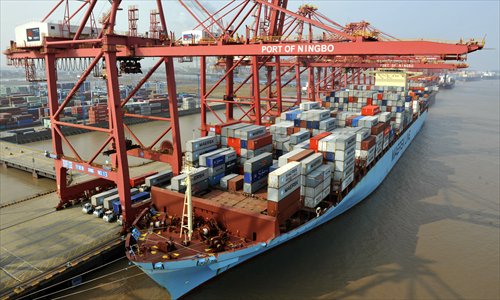ODI driven by enterprises: MOFCOM
Ministry rejects comparisons with Marshall Plan

A container dock at Ningbo Port in East China's Zhejiang Province Photo: CFP
China's outbound investment is not comparable to the Marshall Plan, Shen Danyang, spokesman for the Ministry of Commerce (MOFCOM), told a news conference on Wednesday, at which he revealed statistics showing the country has become a net exporter of capital.
Shen's remarks came after some scholars had compared China's "One Belt and One Road" initiative - referring to the Silk Road Economic Belt and the 21st Century Maritime Silk Road - to the Marshall Plan of 1947.
Officially known as the European Recovery Program, the US-sponsored initiative helped reset the economies of Western Europe after World War II.
While the Marshall Plan was strongly propelled by the US government, China's outbound investment has been mainly driven by enterprises eager to expand overseas and by foreign markets that have welcomed Chinese companies to invest in them, Shen said, noting that the central government has only offered assistance.
The "One Belt and One Road" initiative signifies China's commitment to further open up its economy and revitalize the ancient Silk Road in a mutually beneficial fashion, so comparing it with the Marshall Plan is incorrect, said Xu Hongcai, director of the Department of Information under the China Center for International Economic Exchanges (CCIEE).
Xu told the Global Times on Wednesday that instead of being pushed by the government, China's strong growth in outbound direct investment (ODI) has been given sustained impetus by privately owned enterprises, which are exploring new growth options in overseas markets.
Taking into account profit reinvestment and investment made through third countries, China's ODI stood at about $140 billion for the whole of 2014, roughly $20 billion more than the amount of foreign direct investment (FDI) into the country last year, according to figures disclosed by the spokesman.
That means China was a net exporter of capital in 2014, Shen noted.
China's ODI is expected to grow at a faster pace than the FDI it receives in years to come, he forecast, while noting that FDI is likely to see stable growth.
Shen also said at the news conference that the country's exports saw their best performance in three years in 2014, with actual export growth reaching 8.7 percent for the year, well above an expected global average of less than 2 percent for the past year.
Imports remained weak, with actual growth of 3.3 percent, but Shen said there were several reasons for this, including slumping prices of major commodities and slower domestic investment growth.
Because of the low import growth, China's foreign trade only grew by 3.4 percent year-on-year in dollar terms in 2014, missing its annual growth target for the third year in a row, according to customs data released on January 13.
When asked about recent media reports that the country may cut its annual trade growth target to around 6 percent in 2015 from the previous year's 7.5 percent, Shen said the answer "will be made available in due time."
Traditionally, the annual trade growth target, along with a set of other growth targets, are not announced until the annual sessions of China's national legislature and political advisory body in March.
UBS economists Wang Tao and Harrison Hu said in a research report sent to the Global Times on Wednesday that China will see a bigger trade surplus this year because of the slump in global oil prices.
However, the yuan's exchange rate will remain relatively stable over the course of 2015, they said.
The Chinese currency has reached its equilibrium rate, according to CCIEE's Xu. The growing trade surplus creates appreciation pressure, but this will be offset by the country's increasing capital outflows, Xu noted.